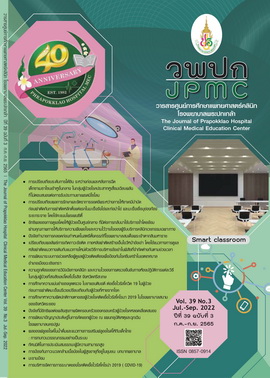Comparison of Outcomes of Stiffness of Knee Joint after Anterior Cruciate Ligament Reconstruction Surgery between The Routine Postoperative Range of Motion Exercise and The Progressive Limited Range of Motion Exercise
Main Article Content
Abstract
BACKGROUND: Arthroscopic anterior cruciate ligament (ACL) reconstruction with routine post-operative care allows for 0-90 degree range of motion exercise, but researchers have found an incidence of knee stiffness of 12.5%. When attempting a wide range of motion exercise immediately after an operation, patients cannot exercise the entire range of motion due to the knee’s limited range of motion, or knee stiffness. Therefore, the researcher has created a new post-operative exercise, named the Progressive Limited Range of Motion exercise (PLROM), to ensure clarity and consistency of knee exercise with a reduced chance of knee stiffness after ACL reconstruction surgery.
OBJECTIVES: To compare the outcomes of stiffness of the knee joint after anterior cruciate ligament reconstruction surgery between the routine postoperative range of motion exercise and the Progressive Limited Range of Motion exercise.
METHODS: This retrospective cohort study, collected from data of patients undergoing arthroscopic ACL reconstruction surgery at Rayong Hospital in Honor of Her Royal Highness Princess Maha Chakri Sirindhorn from 1 October 2019 to 30 June 2021, consisted of a sample of 74 patients divided into two groups: 36 subjects were patients receiving routine post-operative care after surgery, and 38 subjects were patients receiving the PLROM exercise for postoperative care. The two groups were compared through means of knee extension and knee flexion range of motion on the 2nd, 4th, 6th, and 8th week post-operation, respectively. An independent sample t-test was used for the comparative test.
RESULTS: Patients undergoing the PLROM exercise for post-operative care were able to perform knee motion exercises significantly better than the routine post-operative care group. At the 6th and 8th week post-operation, patients in the PLROM group could flex their knee significantly more than patients receiving routine post-operative care.
CONCLUSIONS: A postoperative PLROM exercise can reduce the incidence of knee stiffness after ACL reconstruction surgery. Patients were able to flex their knee at a significantly greater range of motion in both the 6th and 8th week post-operation better than through routine post-operative care. Therefore, the PLROM exercise should be used as a clinical practice to improve a patient's knee motion after ACL reconstruction surgery.
Thaiclinicaltrials.org number, TCTR20220427006
Article Details

This work is licensed under a Creative Commons Attribution-NonCommercial-NoDerivatives 4.0 International License.
References
National statistics office. The 2015 physical activity survey. Bangkok: National Statistical Office; 2016.
Porramatikul M, Watcharaprechasakul V. Management in sports-related knee injuries [Internet]. 2018 [cited 2021 Oct 21]. Available from: https://umcvajira.com/files/pct/ออร์โธ/knee.pdf
Ellman MB, Sherman SL, Forsythe B, LaPrade RF, Cole BJ, Bach BR Jr. Return to play following anterior cruciate ligament reconstruction. J Am Acad Orthop Surg 2015;23:283-96.
Duchman KR, Lynch TS, Spindler KP. Graft selection in anterior cruciate ligament surgery: Who gets what and why?. Clin Sports Med 2017;36:25-33.
Kim S, Bosque J, Meehan JP, Jamali A, Marder R. Increase in outpatient knee arthoscopy in the United States: a comparison of national surveys of ambulatory surgery, 1996 and 2006. J Bone Joint Surg Am 2011; 93:994-1000.
Samitier G, Marcano AI, Alentorn-Geli E, Cugat R, Farmer KM, Moser MW. Current concept review: failure of anterior cruciate ligament reconstruction. Arch Bone Jt Surg 2015;3:220-40.
Stump T, Allen AA, Panariello RA. Rehabilitation and return to play following anterior cruciate ligament reconstruction. Oper Tech Sports Med 2017;25:181-93.
Adams D, Logestedt D, Hunter-Giordano A, Axe MJ, Snyder-Mackler L. Current concepts for anterior cruciate ligament reconstruction: acriterion-base rehabilitation progression. J Orthop Sports PhysTher 2012;42:601-14.
Logerstedt DS, Scalzitti D, Risberg MA, Engebretsen L, Webster KE, Feller J, et al. Knee stability and movement coordination impairments: knee ligament sprain revision 2017. J Orthop Sports Phys Ther [Internet]. 2017[cited 2021 Dec 1];47(11):A1-A47. Available from: https://www.jospt.org/doi/pdf/10.2519/jospt.2017.0303?ref=performancesporthacks
Greenberg EM, Greenberg ET, Albaugh J, Storey E, Ganley TJ. Anterior cruciate ligament reconstruction rehabilitation clinical practice patterns: a survey of the PRiSM society. Orthop J Sports Med [Internet]. 2019 [cited 2022 Apr 15];7(4):2325967119839041. Available from: https://www.ncbi.nlm.nih.gov/pmc/articles/PMC6481008/pdf/10.1177_2325967119839041.pdf
Murawski CD, Wolf MR, Araki D, Muller B, Tashman S, Fu FH. Anatomic anterior cruciate ligament reconstruction: current concepts and future perspective. Cartilage 2013;4 (3 Suppl):27S-37S.
Faul F, Erdfelder E, Lang AG, Buchner A. G*Power 3: a flexible statistical power analysis program for the social, behavioral, and biomedical sciences. Behav Res Methods 2007; 39:175-91.

